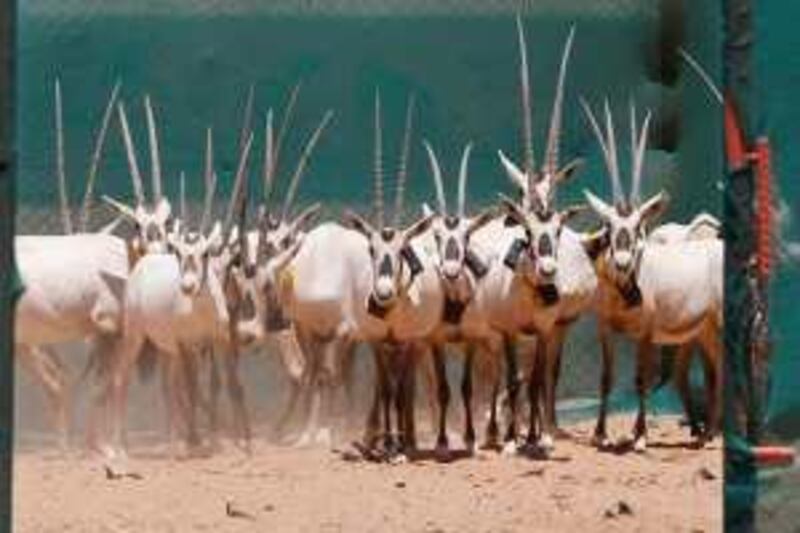WADI RUM, JORDAN // The oryx are at first a little shy about leaving their fenced-in area in the middle of Wadi Rum. Their apprehension is perhaps understandable - the breed has been extinct in this landscape for more than 80 years.
All 20 of these Arabian oryx were flown in from Abu Dhabi three months ago as part of a 2007 conservation agreement between the Environment Agency Abu Dhabi (EAD) and the Al Aqaba Special Economic Zone Authority. And this is the moment of their release into the wild. Though the oryx has not been seen in Jordan since the 1930s, the UAE has one of the world's largest populations, with more than 4,000 currently accounted for.
The US$1.1 million (Dh4m) project which is reintroducing it to this desert in the south of Jordan, also encompasses habitat rehabilitation and educational programmes for the local people. "This is a success story," said Mohammed Al Bawardi, the managing director of the EAD and secretary general of the Abu Dhabi executive council. The plan to reinvigorate a dwindling Arabian oryx population was born, he said, in the 1970s under Sheikh Zayed, the Founding President of the UAE, who kept two breeding pairs in captivity.
The animals now being distributed in the UAE, in Jordan and in other Middle Eastern countries are descended from those four. "The best outcome would be for the release of this base population to add the value of an animal lost over the years back to the area," he said. "The oryx is important in Arab culture; it stands for beauty. We call the eye of the oryx aion elmaha - which means beautiful eyes."
Though only 20 were released at the 720 sq km Wadi Rum Protected Area - eight males and 12 females - Khaldoun Kiwan, the head of the EAD's terrestrial wildlife department, said that should be enough for significant repopulation. "We expect between 30 and 32 animals by the end of this year. January and February is their calving season and some of them are already pregnant." The Arabian is the only breed of oryx to live outside Africa and, like all endangered species, it is vulnerable to the environmental changes caused by development.
"Hunting and habitat destruction made them extinct here originally," Mr Kiwan said. "Cars made it a lot easier for people to come out to this part of the desert and invade the oryx's habitat. Their white colour too makes them easy for hunters to spot." Mr Kiwan expressed optimism, however, that this population would flourish. Similar projects are planned for Saudi Arabia and Iraq, which have both seen their oryx population shrink dramatically.
But the project goes beyond bringing the oryx back from oblivion. Everyone involved, including the local Jordanians, sees its re-emergence as symbolic of a deeper appreciation for the region's Bedouin roots. Mohammed Sabah, 39, runs a camp in Wadi Rum called Sunset. He brought his two sons, aged 10 and 12, to witness the release of the herd. "We are here because this is an important event," he said. "These are real desert animals, they are beautiful."
Putting his hand on his younger son's shoulder, he said it would be sad for his children never to see this animal, which looms so largely in Arabic folklore. "Kids need this. It's good, mostly for them." A group of children from another Wadi Rum camp are also here to see the animals up close. "We brought them because part of what we do at the camp is try to raise awareness of the Bedouin community at Wadi Rum," said Thelma Redwan, a training co-ordinator at the camp. "Something like this also encourages environmentalism, which, if you get it when you're young, you never forget."
Lojain Hanaity, 15, is among those youths. She enrolled in the camp to keep her busy outside the academic year, but has gained much more than just something to do during the summer days. "I want to go into the environmental field when I grow up," she said. "Now, I understand the environment in a way I didn't before. "All these plants and animals mean something to us. We need them. "I want to make a change, do something different when I grow up. Seeing this gives me the confidence."
Other youngsters around her nod in agreement. "God put these here for a reason," says Amani al Sobhi, aged 12. This small population released yesterday travelled from Abu Dhabi in wooden boxes, and after receiving medical check-ups were brought here to the middle of the desert, an area of red sand between granite and sandstone mountains. Their initial hesitation about leaving their square enclosure subsided quickly, as they were herded out by one of the employees at the Wadi Rum Protected Area. They poked their heads out of the newly opened gate, and paused for a brief moment before running away in groups towards the mountain. In a moment, they had disappeared over the horizon. jhume@thenational.ae






